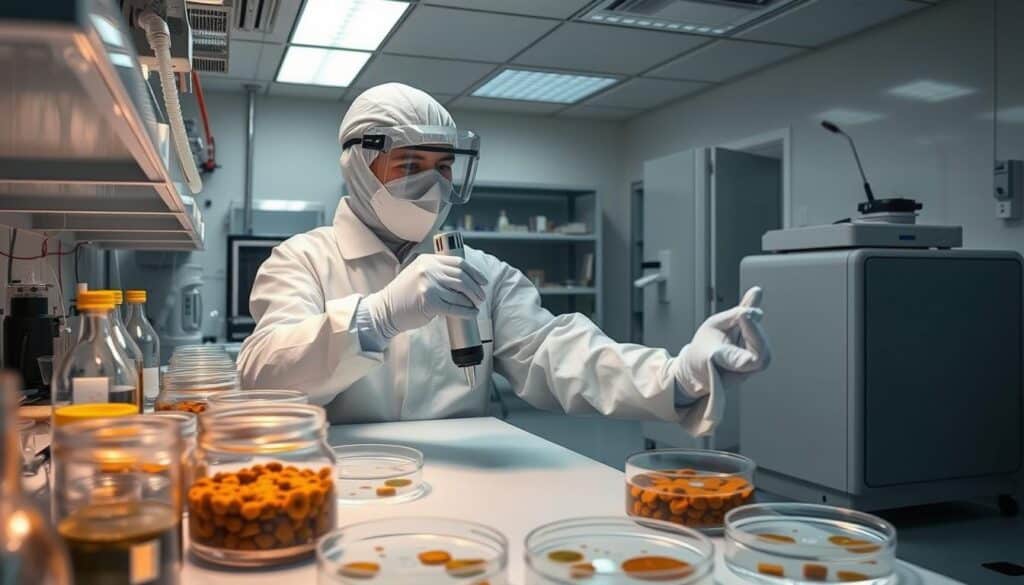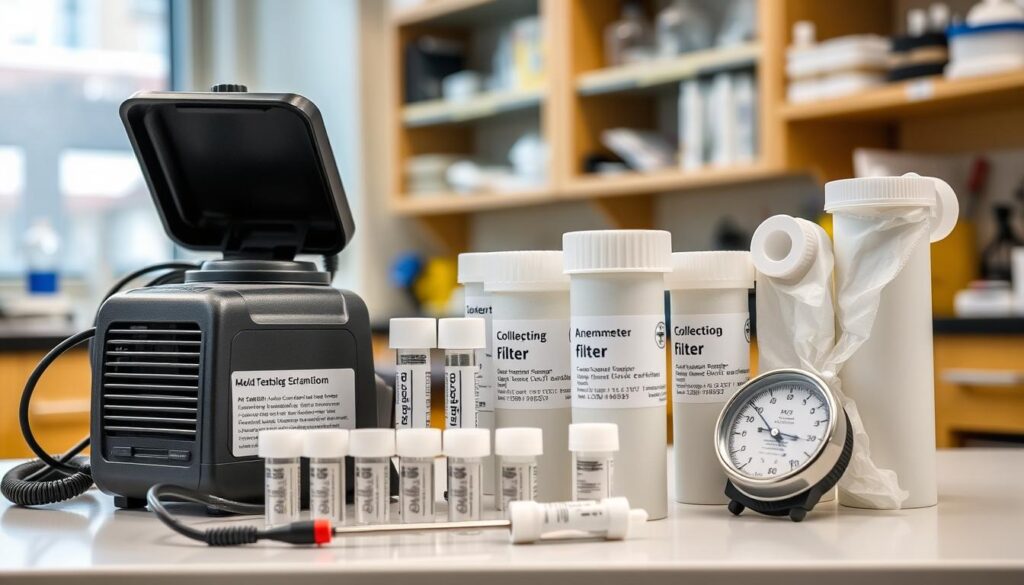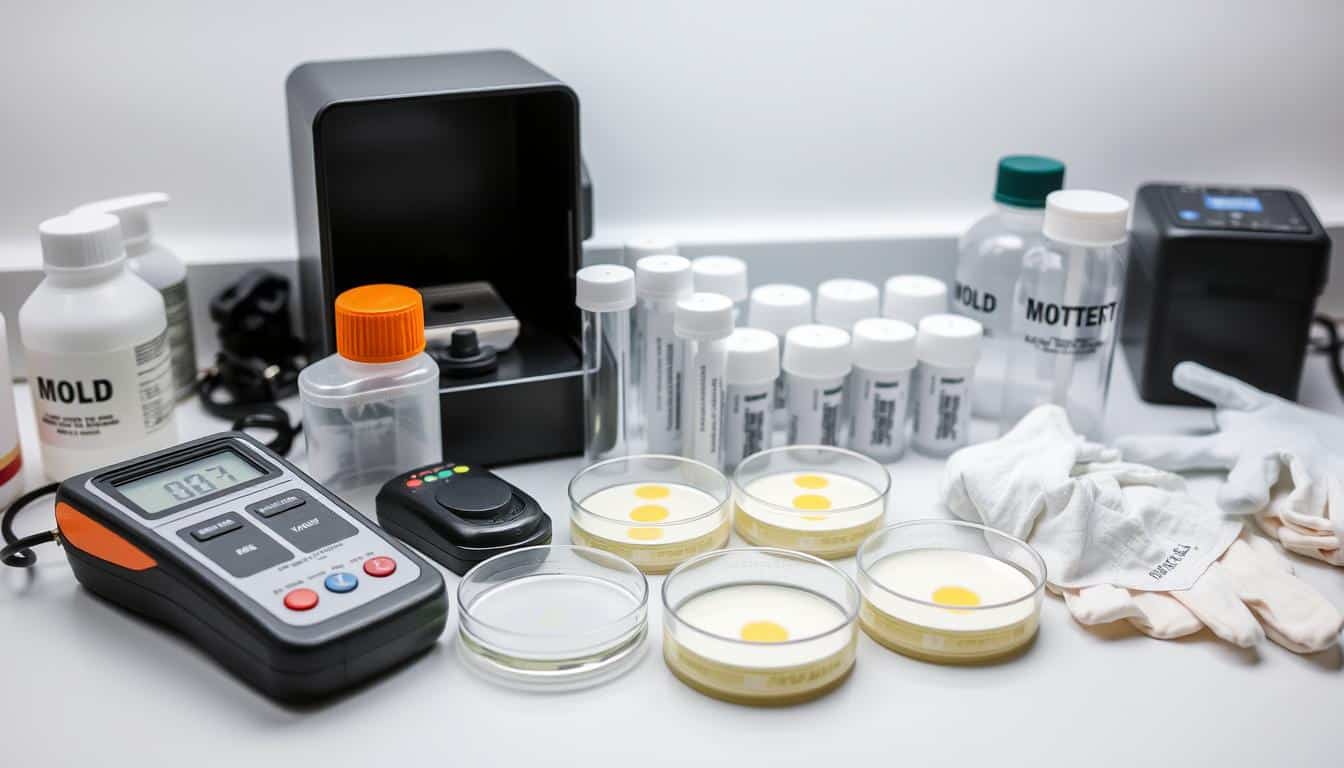Did you know that around 70% of homes in the US have mold? This fact shows how crucial mold testing and checking indoor air quality are. As an expert in environmental testing, I’ve seen how important mold sampling is for a healthy home.
Mold testing is not just a precaution; it’s essential for keeping our homes safe and healthy. We use the latest technology, like moisture detectors and infrared imaging, for detailed mold inspections. These tools help us find mold problems early, giving homeowners a big advantage in preventing and fixing mold.
Modern mold testing is exciting, especially with qPCR (Quantitative Polymerase Chain Reaction) analysis. This advanced method can spot up to 36 different mold types. By mixing this with air, surface, and dust sampling, we get a full view of a property’s mold situation.
Key Takeaways
- About 70% of US homes have some form of mold growth
- Professional mold testing is more accurate than DIY kits
- qPCR analysis can identify up to 36 different mold types
- Indoor spore counts should be roughly 75% of outdoor counts
- Mold testing and mold inspection are distinct services
- Advanced techniques like infrared imaging aid in early mold detection
Understanding Mold Sampling and Its Importance
Mold sampling is key to keeping indoor air clean. As a mold inspector, I’ve seen how it helps find and fix mold problems.
What is mold sampling?
Mold sampling collects air or surface samples to find mold spores. It captures 75 liters of air on a sticky slide. Then, it’s sent to a lab for analysis.
Why is mold sampling necessary?
Mold sampling is vital for several reasons:
- It confirms suspected mold growth
- It assesses contamination levels
- It guides remediation efforts
- It helps identify potentially toxic mold species
The role of mold sampling in property assessment
In property assessment, mold sampling is key. It gives data on indoor air quality and health risks. A detailed mold inspection includes:
| Component | Description |
|---|---|
| Air Samples | Minimum one per level, more based on property size |
| Surface Samples | Taken from visible mold or suspicious areas |
| Environmental Measurements | Wet substructure, relative humidity, CO2, temperature |
| Post-Remediation Testing | Ensures successful mold problem resolution |
Knowing the value of mold sampling is essential for a healthy home. It’s not just about finding mold. It’s about fixing it right and preventing future problems.
Types of Mold Samples: A Comprehensive Overview
In my work as a mold inspector, I’ve learned that knowing about mold sampling methods is key. Let’s look at the main types of samples used in mold testing.
Air sampling
Air sampling is a major technique in air quality testing. I use special air pumps and spore traps to catch airborne mold spores. This helps find out what kinds of mold are in the air and how much.

Surface sampling
Surface sampling is vital for checking visible mold. I often use swabs or tape lifts to get samples from areas that look suspicious. This method is great for identifying specific mold species during an inspection.
Bulk sampling
Bulk sampling takes a piece of material thought to have mold. It’s really useful for materials like drywall or carpet. It gives a detailed look at mold growth in the material.
Dust sampling
Dust sampling is good for checking mold on surfaces. I use it for checks after mold removal and for people who are very sensitive. It’s a good way to see the overall mold situation in a place.
| Sampling Method | Best Used For | Key Benefit |
|---|---|---|
| Air sampling | Detecting airborne spores | Identifies hidden mold sources |
| Surface sampling | Confirming visible mold | Pinpoints specific mold species |
| Bulk sampling | Testing porous materials | Reveals extent of mold penetration |
| Dust sampling | Assessing overall contamination | Ideal for post-remediation checks |
Each sampling method gives different insights into a property’s mold situation. By using all these methods, I can offer a detailed mold testing service. This ensures my clients get a complete environmental test.
The Process of Sampling for Mold
When I start a mold inspection, I first assess the property thoroughly. I use special tools and infrared technology to find problem areas. Then, I create a sampling plan that fits each property’s needs.
I collect samples from areas that might have mold or moisture issues. The number and type of samples depend on the property and suspected problems. Common methods include:
- Surface sampling (swabs and tape lifts)
- Ambient air sampling
- Wall cavity sampling
- Bulk sampling
Surface sampling shows the types of mold present, helping decide how to fix it. Air sampling is common, used to find mold spores indoors. Bulk sampling checks materials for mold growth.
After I collect the samples, they go to a lab for analysis. The lab results are key, affecting people’s health. For non-culture analyses, results come back in 1-3 days. These results help me suggest what to do next, like mold removal or checking for moisture.
Air Sampling Techniques and Equipment
Air sampling is key in mold testing and checking indoor air quality. I use special equipment to collect and study air samples. This gives us important info on mold spores in indoor spaces.
Spore traps and air pumps
Spore traps and air pumps are the main tools for air sampling. They pull air through a medium, catching particles for analysis. Air pumps work at different speeds, and samples are taken for 1 to 10 minutes.

Interpreting air sample results
I compare indoor samples to outdoor ones to understand the results. Indoor counts should be about 75% of outdoor ones. The EPA says counts under 500 spores per cubic meter are usually normal.
Limitations of air sampling
Air sampling is useful but has its limits. Results can change with seasons and how well air moves. That’s why I often mix air sampling with other methods for a full test.
| Sampling Area | Frequency | Analysis Method |
|---|---|---|
| Operating Rooms | 47.8% | Culture-based (60.9%) |
| Protective Environment Rooms | 43.5% | Air particulate (78.3%) |
| Routine Sampling | 47.8% | Direct examination (43.5%) |
Surface Sampling Methods: Swabs, Tape Lifts, and Bulk Samples
In my experience with mold testing, surface sampling methods are key. They include tape lifts, swabs, and bulk samples. Each method has its own benefits in testing and inspection.
Tape lift sampling is fast and affordable. I press clear tape on the suspect area and seal it in a plastic bag. It’s perfect for initial checks and can show all molds present. Surface sampling for mold using tape lifts takes about 3 hours at the lab.
Swab sampling uses sterile culturettes with a buffer solution to swab suspect areas. It’s more expensive and takes longer than tape lifts. But, it can identify both genus and species of mold. This detail is useful in some cases, but all indoor mold should be removed.
Bulk sampling is my top choice for a detailed mold inspection. It involves taking a small piece of the affected material in a sterile container. This method gives the most detailed sample but is more invasive.
| Sampling Method | Processing Time | Cost | Information Provided |
|---|---|---|---|
| Tape Lift | ~3 hours | Less expensive | Genus type |
| Swab | ~10 days | More expensive | Genus and species |
| Bulk | Varies | Moderate | Comprehensive analysis |
When doing a moisture assessment, remember that surface sampling gives semi-quantitative results. These results help find mold growth and how widespread it is. It’s vital to handle samples carefully and get them to the lab quickly for accurate results.
Advanced Mold Testing: qPCR and ERMI Analysis
In my experience, advanced mold testing methods like qPCR and ERMI give us deep insights into indoor air quality. These methods look beyond traditional mold testing, showing us more about mold contamination.
What is qPCR testing?
qPCR, or Quantitative Polymerase Chain Reaction, is a modern way to test for mold. It finds mold DNA, giving us exact details on mold types and amounts. The cost for a qPCR DNA test is between $225 and $400, making it a pricey but precise tool for planning mold removal.
Understanding ERMI analysis
ERMI, or Environmental Relative Moldiness Index, checks mold levels through dust samples. It looks at 36 mold species, giving a score from -10 to +30. A higher score means more mold. Yet, ERMI only covers about 15% of molds found indoors.
Pros and cons of advanced testing methods
These advanced tests give us detailed information but have their downsides. qPCR is great for finding specific mold types, which helps in targeted removal. ERMI gives a standard mold index but might not show exact problem spots. Both are pricier than basic tests, starting at $600 for professional air testing.
Even with their benefits, these tests should be used with other methods like visual inspections. This way, we get a full picture of indoor air quality.
| Method | Pros | Cons |
|---|---|---|
| qPCR | Precise species identification, Highly accurate | Expensive, Requires specialized lab analysis |
| ERMI | Standardized index, Analyzes multiple species | Limited coverage of indoor molds, May not pinpoint specific problem areas |
The Importance of Outdoor Control Samples
Outdoor control samples are vital for mold testing. They give us a baseline to compare against. This helps us see what’s normal in our environment. In my experience, indoor spore counts should be about 75% of outdoor counts.
Mold inspection is more than just finding mold inside. It’s about understanding the bigger picture. Outdoor spore types and concentrations change a lot due to weather. For example, windy days can have high spore counts, while snow-covered ground has low counts.
Here’s a breakdown of recommended sampling practices:
- IAC2 guidelines suggest 3 air samples: 2 outside, 1 inside
- Some companies offer 2 samples: 1 outdoor control, 1 indoor
- EMlab recommends 2 outdoor samples and 2 in each room of concern
In my air quality testing work, I’ve found that taking multiple outdoor samples gives more accurate results. It’s important to note that while home mold test kits can be helpful, they don’t offer the same level of detail as professional testing.
Remember, mold is naturally present in our environment. The real question is if indoor levels are abnormal compared to outdoor air. This relative moldiness is what truly matters in assessing a property’s condition during a mold inspection.
Developing a Comprehensive Mold Sampling Strategy
Creating a good mold sampling strategy is key for accurate testing. I’ll show you the important steps and things to avoid.
Factors Influencing Sampling Decisions
When planning your mold sampling strategy, think about these factors:
- Visible mold growth
- Moisture issues
- Occupant health concerns
- Property size and condition
- Building history
Creating a Tailored Sampling Plan
A good sampling plan should use different methods for a full mold check:
| Sampling Method | Best Use | Effectiveness |
|---|---|---|
| Swab sampling | Small, localized areas | High for visible mold |
| Tape lift sampling | Flat surfaces (walls, floors) | Excellent for surface mold |
| Bulk sampling | Comprehensive analysis | Best for material testing |
| Wall cavity sampling | Hidden mold growth | Effective for concealed areas |
| Dust sampling | Long-term monitoring | Good for air quality assessment |
Common Pitfalls to Avoid
Watch out for these mistakes in mold remediation:
- Relying solely on air samples
- Neglecting outdoor control samples
- Ignoring occupant experiences
- Overlooking hidden moisture sources
Professional mold inspection and moisture assessment are crucial. For detailed inspections, call Property360 at (904) 503-9808.
Interpreting Mold Test Results: What the Numbers Mean
Understanding mold test results is key to keeping indoor air clean. It helps decide if you need to remove mold. I’ve learned that reading these numbers can be hard, but it’s vital for checking the air quality.
In my experience, having less than 500 mold spores per cubic meter of air is usually okay. But, if you find more, it might mean there’s a problem. Remember, mold is common in about 70% of U.S. homes, so finding some is normal.
Here’s a simple guide to spore counts and what they mean:
- 0-50 spores: Generally not problematic
- 50-200 spores: Low levels
- 200-500 spores: Within normal ranges
- 1500-3000 spores: Potential issues, further inspection needed
- 3000-10,000 spores: May require remediation
- 25,000-75,000+ spores: Significant mold issue, professional remediation necessary
When I look at mold test results, I compare indoor samples to outdoor ones. This helps figure out if the mold is inside or outside. Some mold types, like Penicillium and Aspergillus, usually have fewer than 700 cts/m3 indoors.
Environmental testing reports often suggest when to remove mold. But, it’s best to get help from a pro. They can give you the right advice for clean indoor air.
When to Hire a Professional for Mold Sampling
Mold problems can be complex. Sometimes, you might think you can tackle it alone. But, there are times when you really need a pro for mold sampling. Getting experts to check your indoor air quality can be a game-changer.
Benefits of Professional Mold Testing
Professional mold testing has many perks. Experts bring specialized gear for precise sampling and detailed result analysis. They spot hidden mold that might not be seen by the naked eye. This thorough method gives a full picture of your mold situation.
Choosing a Qualified Mold Inspector
When picking a mold inspector, check for certifications and experience. A good inspector knows mold science and mold removal methods well. Make sure they use the latest tech for testing.
What to Expect During a Professional Mold Inspection
A pro mold inspection includes a close look and moisture checks. The inspector will take targeted samples based on your home’s specifics. They’ll tell you how big the mold issue is and suggest the best ways to fix it.
| Inspection Element | Purpose |
|---|---|
| Visual Assessment | Identify visible mold growth |
| Moisture Readings | Detect potential mold-prone areas |
| Air Sampling | Measure airborne mold spores |
| Surface Sampling | Identify mold species present |
If mold covers more than 10 square feet, it’s time to call the pros. They ensure safe removal and cleaning, keeping you and your home safe.
Conclusion
I’ve looked into mold testing and its key role in keeping air inside homes clean. Mold inspection is a detailed process that needs careful sampling and expert analysis. Air sampling is a main way to find out about mold spores in homes.
Experts use tools like impaction samplers and cassette samplers for air samples. These samples are compared to outdoor air to get a full picture. But, air sampling is only part of the job. A full mold inspection also includes looking around and collecting other data.
Getting mold samples right is key for finding and measuring mold. This info helps plan how to fix mold problems. But, wrong sampling can give wrong results or spread mold spores. That’s why it’s smart to let pros handle mold testing and fixing.
Knowing how important mold testing and inspection are helps us keep homes healthy. Whether you own a home or manage a property, knowing about mold is important. It helps keep everyone living there safe and healthy.
FAQ
What is mold sampling?
Mold sampling is the process of collecting and analyzing samples to find mold in a property. It uses air, surface, and bulk sampling to detect mold.
Why is mold sampling necessary?
It’s key to confirm mold growth and assess contamination levels. It helps guide the right steps to fix mold issues. It also checks indoor air quality and health risks.
What are the different types of mold samples?
There are air, surface, and dust samples. Air samples use pumps and spore traps. Surface samples include swab, tape lift, and bulk samples. Dust samples check contamination on surfaces and contents.
How is air sampling for mold performed?
Air sampling uses pumps to draw air through spore traps. The air volume and speed are important. Results are compared to outdoor samples.
What are the different surface sampling methods for mold?
Surface sampling includes swab, tape lift, and bulk sampling. Swab sampling uses a Q-Tip-like tool. Tape lift uses special tape. Bulk sampling removes a piece of affected material.
What is qPCR and ERMI analysis for mold testing?
qPCR tests for mold DNA for detailed analysis. ERMI uses dust samples to check mold levels by analyzing 36 species. These methods give detailed insights but are pricey.
Why are outdoor control samples important in mold sampling?
Outdoor control samples set a baseline for comparison. Indoor spore counts should be about 75% of outdoor counts. This ensures accurate assessment of mold condition.
How is a comprehensive mold sampling strategy developed?
A strategy is tailored to each property’s unique conditions. It considers visible mold, moisture, and health concerns. It selects the right sample types and quantities based on the property’s size and condition.
How are mold test results interpreted?
Results are interpreted by looking at mold spore types and quantities. They are compared to outdoor samples and industry standards. Spore counts, mold types, and health impacts are considered.
Why should I hire a professional for mold sampling?
Professionals offer accurate sampling and result interpretation. They have certifications and experience in mold science. They conduct a detailed assessment, including moisture readings and strategic sampling.




